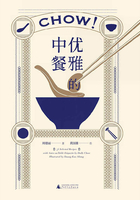
METHODS OF COOKING
1. Shao K'ao(烧烤)means Roasting.
There are two different ways of doing this: one is roasting over an open fire known as Ming Lu(明炉),while the other is roasting in an oven K'ao Lu(烤炉).
By the first mentioned method we prepare roast suckling pig and barbecued Peking duck. In exactly the same way the Russians make “shaslick”  and the Javanese “sateh”
and the Javanese “sateh”  dishes, which are well known to foreigners in the Orient. The Cantonese dish known as “gold coin chicken” consisting of a combination of alternate pieces of ham, chicken and pork is made the same way. Material for barbecuing should be hung for 6 to 7 hours, and then covered with the proper condiments. Then it is fixed to a metal fork or skewer and held over a strong charcoal fire. Constant turning of the forks is necessary to ensure even roasting. In barbecuing a whole pig the skin should be punctured
dishes, which are well known to foreigners in the Orient. The Cantonese dish known as “gold coin chicken” consisting of a combination of alternate pieces of ham, chicken and pork is made the same way. Material for barbecuing should be hung for 6 to 7 hours, and then covered with the proper condiments. Then it is fixed to a metal fork or skewer and held over a strong charcoal fire. Constant turning of the forks is necessary to ensure even roasting. In barbecuing a whole pig the skin should be punctured

A Chinese Oven中国炉
before roasting to secure an even surface at the end of the operation.
A Chinese oven is usually built of brick and clay, with two openings, one below and one above in the form of a very short chimney. A charcoal fire is started inside. After half an hour when the oven is sufficiently hot, the fire is damped down by placing a thin metal sheet over the charcoal. The material to be roasted is hung inside the oven, and both openings are closed. The result is identical with that of a modern gas or electric oven.
2. Chêng(蒸)means Steaming.
This is a simple and economical process of cooking with steam rising from boiling water. By this method the nutritive juice and flavour of the material are conserved. It is specially recommended for preparing fish. In the home, steaming is very often carried out by utilising the steam from boiling rice. At other times it is done by means of a special cooker made of split bamboo called Chêng Lung(蒸笼)meaning a steam cage.In steaming Chiao Tzu(饺子)or dumplings,these are placed directly on a piece of damp cloth spread over the cage instead of on China plates. This method of cooking is frequently used at home, but not often in restaurants.
3. Ch'ao(炒)means Frying with a little fat over a quick fire. Frequent quick turning is essential.
Most of the expensive dishes are prepared by this way of cooking. The important point in this process is the high temperature employed, which ensures quick cooking. If the temperature is not sufficiently high, the meat will not be tender. On this account it is not advisable to fry more than a pound of meat at a time: if more is needed the process should be repeated several times. When more than one ingredient has to be dealt with, they should be first fried separately and then mixed together, the meat being left to the last always. The Chinese frying pan being convex, and not flat bottomed, the turning is more conveniently done.
4. Chien(煎)means Sautéing or Frying with a small quantity of fat over a gentle fire. Turning is necessary only when the meat has sufficiently browned.
This process is also applied as a preliminary treatment to poultry and meat before stewing or boiling, for two reasons. Firstly, it makes the meat more palatable. Secondly, it tends to eliminate any excessive “muttony” or “fishy” flavour.
5. Cha(炸)means Frying in deep fat at a high temperature.
The substance to be cooked by this process is immersed in boiling oil. Sometimes the meat is covered with a coating of flour before it is dropped into the oil, to prevent toughening or overcooking. Meat treated by this process is very indigestable, though it is very tasty, so it is not advisable to employ this method too frequently at home.
6. Mên(焖)means Stewing.
By this method the meat and vegetables are cooked together with a small quantity of water at a moderate temperature for a long time. The juices of the meat and vegetables are retained in the liquid and the long and slow process of cooking renders the material both tender and delicious.
7. Tun(炖)means cooking by use of a double boiler.
The material for cooking is contained in a covered vessel like a casserole-dish placed in a pan of boiling water. Meat so treated is more palatable than by simply boiling. More water is required than in stewing, otherwise the process is much the same. This is the best way of making soup, when special care should be exercised to seal down the cover with wet tissue paper. In winter this process is very popular.
8. Ao(熬)means Simmering.
This is a simple process of boiling very slowly. Care must be taken to avoid too rapid evaporating, and not to uncover the pot too often. The simmering process must be continued without interruption until the time of serving.It is also termed Po(煲).